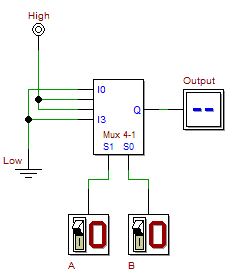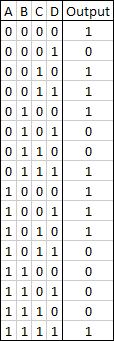

Due Feb 18
The seven-segment LED shown below can be used to display any hexadecimal digit. For each of the seven segments there is a four-variable Boolean function that outputs a one when that segment is to be lit and zero otherwise. Generate the truth table for segment 5, write the sum of products expression, simplify the expression using a Karnaugh map, and implement the corresponding circuit using DEEDS.

A multiplexer has n control lines, 2n input lines and 1 output. When the values of the control lines are interpreted as a number, the corresponding input is passed through to the output.
A truth table describing a binary function of n variables has 2n rows and 1 output column (the function result). When the values of the n variables are interpreted as a number, the desired output is found on the corresponding row of the truth table.
Given the remarkable similarity of a truth table and multiplexer, it should come as no surprise that any binary function of n variables can be implemented using a multiplexer with n control lines. A simple example is shown below. Each input to the multiplexer is the value of the function in the corresponding row of the truth table and the values for A and B select which of these input lines will appear at the output.
 |
 |
In DEEDS, you'll find decoders, multiplexers, and demultiplexers on the component toolbar in the group of components just to the right of the basic logic gates.
a) Use a multiplexer with 3 control lines to implement the function defined by the truth table below.

b) Use a multiplexer with only 2 control lines to implement this same function. This is a bit more challenging and you'll need to put on your thinking cap. Hint: Connect A to S1 and B to S0. Look for patterns in the pairs of rows that correspond to the different values of AB.
a) Use a multiplexer with 4 control lines to implement the function defined by the truth table below.

b) Use a multiplexer with only 3 control lines to implement this same function.